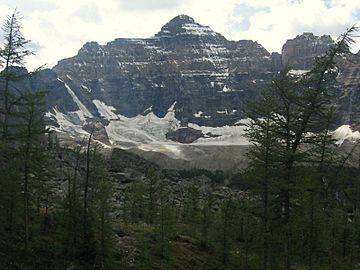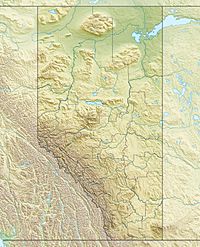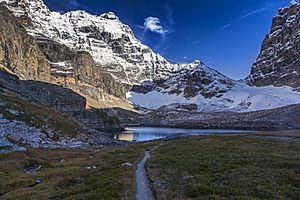Mount Hungabee facts for kids
Quick facts for kids Mount Hungabee |
|
|---|---|
| Hungabee Mountain | |

As seen from Paradise Valley in 2007
|
|
| Highest point | |
| Elevation | 3,492 m (11,457 ft) |
| Prominence | 987 m (3,238 ft) |
| Geography | |
| Country | Canada |
| Parent range | Bow Range |
| Topo map | NTS 82N/08 |
| Climbing | |
| First ascent | 21 July 1903 |
| Easiest route | rock/snow climb |
Mount Hungabee, also known as Hungabee Mountain, is a tall mountain in Canada. It sits right on the border of Banff National Park and Yoho National Park. This mountain is also part of the Continental Divide. This is a high line of mountains where rivers on one side flow to the Pacific Ocean, and rivers on the other side flow to the Atlantic or Arctic oceans.
The peak was named in 1894 by Samuel Allen. He used a word from the Stoney Indian (also called Nakoda) language. "Hungabee" means "chieftain" because this mountain stands taller than its neighbors. You can see Mount Hungabee from the Icefields Parkway (#93), a famous scenic road in the Bow Valley.
Contents
Climbing Mount Hungabee
First Climbers
Mount Hungabee was first climbed in 1903. The climbers were H.C. Parker and his guides, Hans Kaufmann and Christian Kaufmann.
Climbing Routes
The most common way to climb Mount Hungabee is along its west ridge. This route can be challenging to find your way through. It's not a good idea to climb in early summer. This is because there can be a risk of avalanches from snow on the northwest side of the mountain.
How Mount Hungabee Was Formed
Mount Hungabee is made of sedimentary rock. This type of rock forms from layers of sand, mud, and shells that build up over time. These layers were laid down in shallow seas a very long time ago. This happened during the Precambrian and Jurassic periods.
Later, during a big event called the Laramide orogeny, these rock layers were pushed up. This movement created the mountains we see today, including Mount Hungabee.
Climate Around Mount Hungabee
Mount Hungabee is in a subarctic climate zone. This means it has very cold and snowy winters. The summers are usually mild. Temperatures can drop below −20 degrees Celsius. With the wind chill, it can feel even colder, sometimes below −30 degrees Celsius.
See also
 In Spanish: Monte Hungabee para niños
In Spanish: Monte Hungabee para niños



